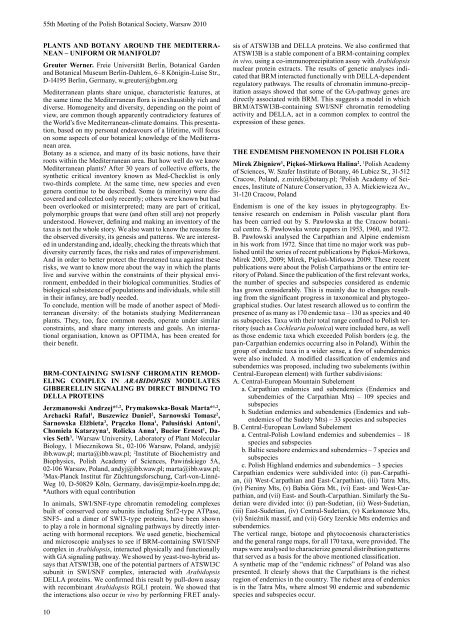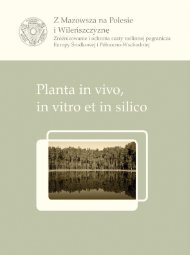acta societatis botanicorum poloniae - LV Zjazd Polskiego ...
acta societatis botanicorum poloniae - LV Zjazd Polskiego ...
acta societatis botanicorum poloniae - LV Zjazd Polskiego ...
You also want an ePaper? Increase the reach of your titles
YUMPU automatically turns print PDFs into web optimized ePapers that Google loves.
55th Meeting of the Polish Botanical Society, Warsaw 2010<br />
PLANTS ANd BOTANY ArOUNd THE MEdITErrA-<br />
NEAN – UNIFOrM Or MANIFOLd?<br />
Greuter Werner. Freie Universität Berlin, Botanical Garden<br />
and Botanical Museum Berlin-Dahlem, 6– 8 Königin-Luise Str.,<br />
D-14195 Berlin, Germany, w.greuter@bgbm.org<br />
Mediterranean plants share unique, characteristic features, at<br />
the same time the Mediterranean flora is inexhaustibly rich and<br />
diverse. Homogeneity and diversity, depending on the point of<br />
view, are common though apparently contradictory features of<br />
the World’s five Mediterranean-climate domains. This presentation,<br />
based on my personal endeavours of a lifetime, will focus<br />
on some aspects of our botanical knowledge of the Mediterranean<br />
area.<br />
Botany as a science, and many of its basic notions, have their<br />
roots within the Mediterranean area. But how well do we know<br />
Mediterranean plants? After 30 years of collective efforts, the<br />
synthetic critical inventory known as Med-Checklist is only<br />
two-thirds complete. At the same time, new species and even<br />
genera continue to be described. Some (a minority) were discovered<br />
and collected only recently; others were known but had<br />
been overlooked or misinterpreted; many are part of critical,<br />
polymorphic groups that were (and often still are) not properly<br />
understood. However, defining and making an inventory of the<br />
taxa is not the whole story. We also want to know the reasons for<br />
the observed diversity, its genesis and patterns. We are interested<br />
in understanding and, ideally, checking the threats which that<br />
diversity currently faces, the risks and rates of impoverishment.<br />
And in order to better protect the threatened taxa against these<br />
risks, we want to know more about the way in which the plants<br />
live and survive within the constraints of their physical environment,<br />
embedded in their biological communities. Studies of<br />
biological subsistence of populations and individuals, while still<br />
in their infancy, are badly needed.<br />
To conclude, mention will be made of another aspect of Mediterranean<br />
diversity: of the botanists studying Mediterranean<br />
plants. They, too, face common needs, operate under similar<br />
constraints, and share many interests and goals. An international<br />
organisation, known as OPTIMA, has been created for<br />
their benefit.<br />
BrM-CONTAINING SWI/SNF CHrOMATIN rEMOd-<br />
ELING COMPLEx IN ArAbidoPsis MOdULATES<br />
GIBBErELLIN SIGNALING BY dIrECT BINdING TO<br />
dELLA PrOTEINS<br />
Jerzmanowski Andrzej* 1,2 , Prymakowska-Bosak Marta* 1,2 ,<br />
Archacki Rafał1 , Buszewicz daniel2 , Sarnowski Tomasz2 ,<br />
Sarnowska Elżbieta 3 , Prączko Ilona1 , Palusiński Antoni1 ,<br />
Chomiela Katarzyna1 , rolicka Anna1 , Bucior Ernest1 , davies<br />
Seth3 . 1Warsaw University, Laboratory of Plant Molecular<br />
Biology, 1 Miecznikowa St., 02-106 Warsaw, Poland, andyj@<br />
ibb.waw.pl; marta@ibb.waw.pl; 2Institute of Biochemistry and<br />
Biophysics, Polish Academy of Sciences, Pawińskiego 5A,<br />
02-106 Warsaw, Poland, andyj@ibb.waw.pl; marta@ibb.waw.pl;<br />
3Max-Planck Institut für Züchtungsforschung, Carl-von-Linné-<br />
Weg 10, D-50829 Köln, Germany, davis@mpiz-koeln.mpg.de;<br />
*Authors with equal contribution<br />
In animals, SWI/SNF-type chromatin remodeling complexes<br />
built of conserved core subunits including Snf2-type ATPase,<br />
SNF5- and a dimer of SWI3-type proteins, have been shown<br />
to play a role in hormonal signaling pathways by directly interacting<br />
with hormonal receptors. We used genetic, biochemical<br />
and microscopic analyses to see if BRM-containing SWI/SNF<br />
complex in Arabidopsis, interacted physically and functionally<br />
with GA signaling pathway. We showed by yeast-two-hybrid assays<br />
that ATSWI3B, one of the potential partners of ATSWI3C<br />
subunit in SWI/SNF complex, interacted with Arabidopsis<br />
DELLA proteins. We confirmed this result by pull-down assay<br />
with recombinant Arabidopsis RGL1 protein. We showed that<br />
the interactions also occur in vivo by performing FRET analy-<br />
10<br />
sis of ATSWI3B and DELLA proteins. We also confirmed that<br />
ATSWI3B is a stable component of a BRM-containing complex<br />
in vivo, using a co-immunoprecipitation assay with Arabidopsis<br />
nuclear protein extracts. The results of genetic analyses indicated<br />
that BRM interacted functionally with DELLA-dependent<br />
regulatory pathways. The results of chromatin immuno-precipitation<br />
assays showed that some of the GA-pathway genes are<br />
directly associated with BRM. This suggests a model in which<br />
BRM/ATSWI3B-containing SWI/SNF chromatin remodeling<br />
activity and DELLA, act in a common complex to control the<br />
expression of these genes.<br />
THE ENdEMISM PHENOMENON IN POLISH FLOrA<br />
Mirek Zbigniew 1 , Piękoś-Mirkowa Halina 2 . 1 Polish Academy<br />
of Sciences, W. Szafer Institute of Botany, 46 Lubicz St., 31-512<br />
Cracow, Poland, z.mirek@botany.pl; 2 Polish Academy of Sciences,<br />
Institute of Nature Conservation, 33 A. Mickiewicza Av.,<br />
31-120 Cracow, Poland<br />
Endemism is one of the key issues in phytogeography. Extensive<br />
research on endemism in Polish vascular plant flora<br />
has been carried out by S. Pawłowska at the Cracow botanical<br />
centre. S. Pawłowska wrote papers in 1953, 1960, and 1972.<br />
B. Pawłowski analysed the Carpathian and Alpine endemism<br />
in his work from 1972. Since that time no major work was published<br />
until the series of recent publications by Piękoś-Mirkowa,<br />
Mirek 2003, 2009; Mirek, Piękoś-Mirkowa 2009. These recent<br />
publications were about the Polish Carpathians or the entire territory<br />
of Poland. Since the publication of the first relevant works,<br />
the number of species and subspecies considered as endemic<br />
has grown considerably. This is mainly due to changes resulting<br />
from the significant progress in taxonomical and phytogeographical<br />
studies. Our latest research allowed us to confirm the<br />
presence of as many as 170 endemic taxa – 130 as species and 40<br />
as subspecies. Taxa with their total range confined to Polish territory<br />
(such as Cochlearia polonica) were included here, as well<br />
as those endemic taxa which exceeded Polish borders (e.g. the<br />
pan-Carpathian endemics occurring also in Poland). Within the<br />
group of endemic taxa in a wider sense, a few of subendemics<br />
were also included. A modified classification of endemics and<br />
subendemics was proposed, including two subelements (within<br />
Central-European element) with further subdivisions:<br />
A. Central-European Mountain Subelement<br />
a. Carpathian endemics and subendemics (Endemics and<br />
subendemics of the Carpathian Mts) – 109 species and<br />
subspecies<br />
b. Sudetian endemics and subendemics (Endemics and subendemics<br />
of the Sudety Mts) – 33 species and subspecies<br />
B. Central-European Lowland Subelement<br />
a. Central-Polish Lowland endemics and subendemics – 18<br />
species and subspecies<br />
b. Baltic seashore endemics and subendemics – 7 species and<br />
subspecies<br />
c. Polish Highland endemics and subendemics – 3 species<br />
Carpathian endemics were subdivided into: (i) pan-Carpathian,<br />
(ii) West-Carpathian and East-Carpathian, (iii) Tatra Mts,<br />
(iv) Pieniny Mts, (v) Babia Góra Mt., (vi) East- and West-Carpathian,<br />
and (vii) East- and South-Carpathian. Similarly the Sudetian<br />
were divided into: (i) pan-Sudetian, (ii) West-Sudetian,<br />
(iii) East-Sudetian, (iv) Central-Sudetian, (v) Karkonosze Mts,<br />
(vi) Śnieżnik massif, and (vii) Góry Izerskie Mts endemics and<br />
subendemics.<br />
The vertical range, biotope and phytocoenosis characteristics<br />
and the general range maps, for all 170 taxa, were provided. The<br />
maps were analysed to characterize general distribution patterns<br />
that served as a basis for the above mentioned classification.<br />
A synthetic map of the “endemic richness” of Poland was also<br />
presented. It clearly shows that the Carpathians is the richest<br />
region of endemics in the country. The richest area of endemics<br />
is in the Tatra Mts, where almost 90 endemic and subendemic<br />
species and subspecies occur.



